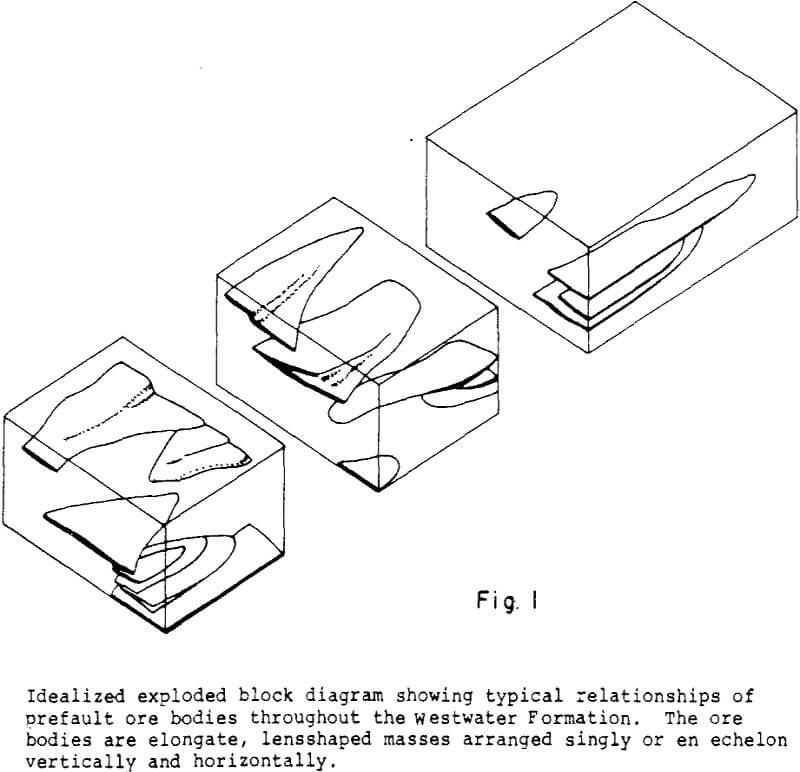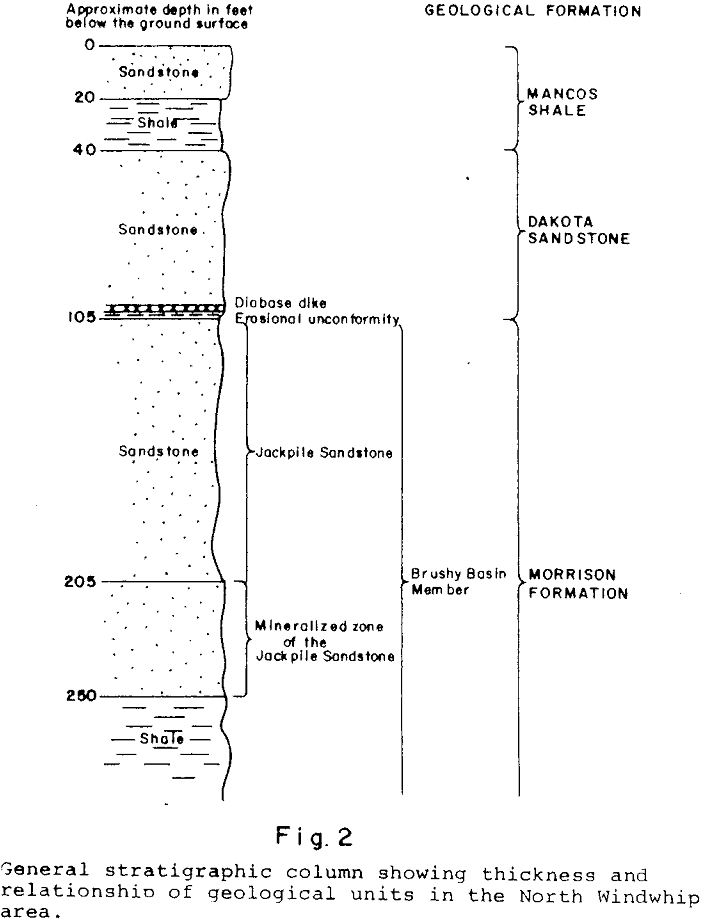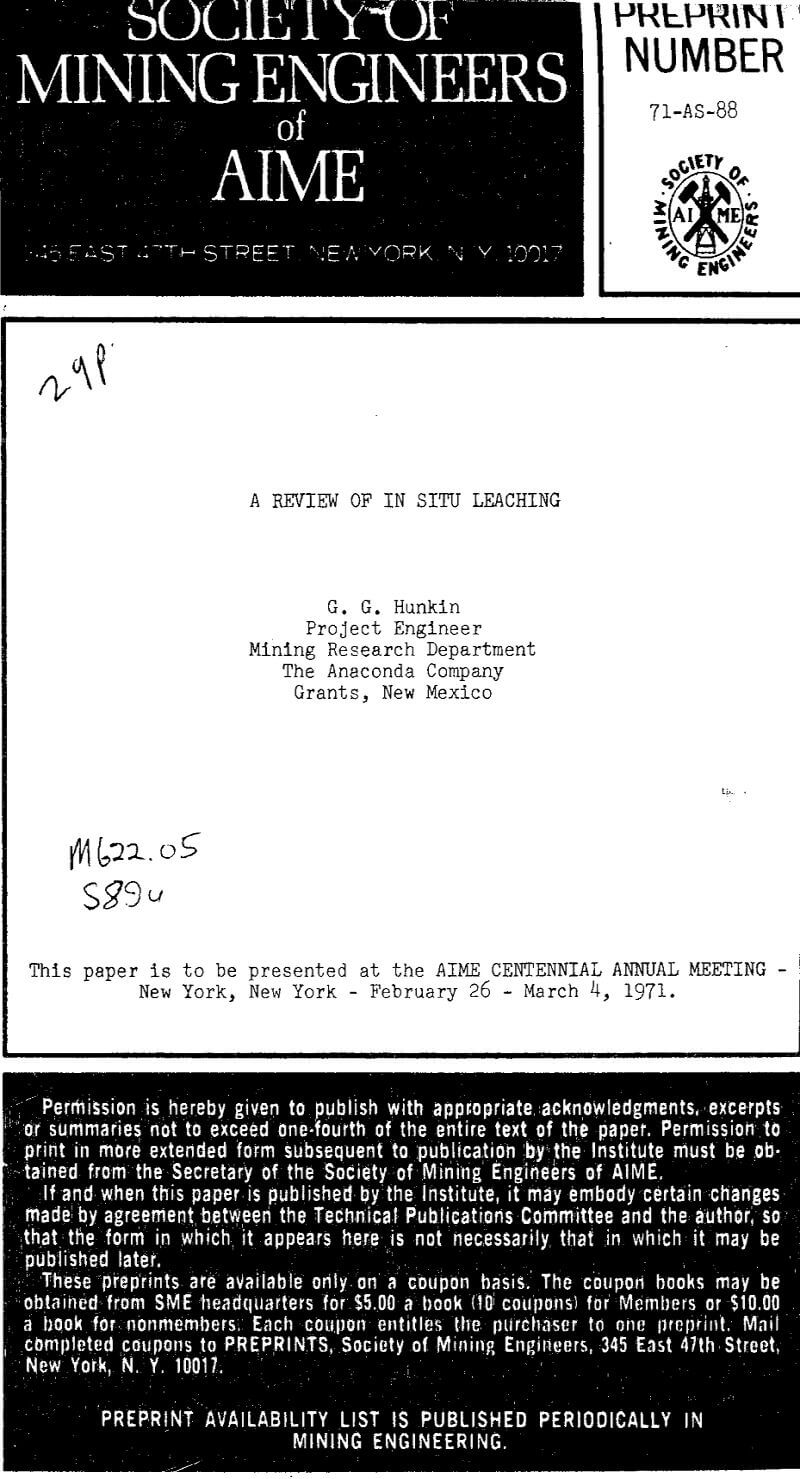Table of Contents
The in-situ leaching project at San Manuel was initially designed to utilize gravity flow leaching to recover oxidised copper from partially rubblized and supergene mineralized rock that was spatially situated adjacent to an abandoned portion of the block cave underground mine. During the construction of this in-situ leaching system, an underground drainage gallery collection facility was adapted by utilizing existing haulage and panel drifts and commissioned with a full scale 3785 liter per minute production test.
Supergene Hydrogeology
The host rock types at San Manuel are a Precambrian quartz monzonite and a younger granodiorite porphyry. Both rock types are fractured and faulted by Basin and Range tectonics, weathered and altered by supergene leaching, and mineralized by supergene precipitation. Locally moderate supergene enrichment is evident in areas of unleached residual sulfides and is characterized by digenite rimming on pyrite and chalcopyrite. The supergene mineralization is structurally and hydrogeologically controlled so the location and attitude of faults and joint orientation must be taken into account during well pattern design. The supergene mineralogy is composed of chrysocolla primarily as fracture fillings and as a coating with clays on altered feldspars.
Current Design Techniques
The well pattern presently utilized at San Manuel is an evolving design as operational experience is gained through continued efficiency performance monitoring and economic valuation. The design incorporates a spatially modified seven-spot pattern coupled with optimized well spacing so that the pattern geometrically fits on an open pit wall catch bench. The current optimum perimeter corner-to-corner well spacing is roughly 12.2 meters. The present in-situ catch benches are 19.8 meters wide from toe to crest excluding spill at the toe. Along the length of the bench, the seven-spot patterns are linked or coupled in a manner that allows design modifications to be made to optimize the position of the linked patterns to fit the localized structural geology.
It is beneficial to drill and log portions of the injection well array very early in the construction phase to confirm the initial geologic interpretation of the well pattern design. This is done so that the design can be modified and re-developed depending upon actual encountered hydrogeologic conditions. Although major changes are usually not required, all designs are continually checked and adjusted as new drilling information is acquired from the last drilled hole. The cuttings from most injection and production drillholes are logged and some selected drillholes are assayed to supplement the mine model database or to further the knowledge of the acid soluble mineralogy of the targeted zone.
Drilling Methods and Well Completion
The current well drilling methods utilized at San Manuel are the product of trial and error experimentation with different well drilling techniques. Some of the sure significant errors in experimentation involved the implementation of drag bits as cutting tools. These bit trials failed due to the blinding off of the blades by clay and silt in the relatively hard and brittle granitic rocks at San Manuel. The most successful drilling trials are represented by the current construction methods now employed. Some of the successful drilling experiments include the use of retractable blades on reaming tools, knock off bit subs, and telescopic casing sleeves to drill through fault zones. Drilling methods are always evolving and being modified as new ways of drilling more productively are developed. The current drilling methods at San Manual are summarized below.
Production wells for well-to-well leaching are drilled vertically with and rotary techniques. Mud composition is bentonite-based with polymer added for viscosity. Unitized and mixing and delivery systems are utilised for and rotary drilling and take the place of mud pits and auxiliary pumping units. These units have proven to provide quality and, decrease total drilling coats, and increase productivity. Mud loss and dilution is minimal in the granitic rock which is indicative of an in-place undisturbed rock mass.
Pump Determination and Setting
The subaersible pumps utilized for excavating PLS from the production wells are constructed of 304 stainless steel. The pump sizes that are utilized are of varying flowrate designs and are powered by 316 stainless steel 10 and 15 horsepower motors. Well hydraulic requirements are such that pump capacities range from 37.9 to 567.8 liters per minute discharge volume. The pump units with ten horsepower motors are 10.2 centimeter O.D. and are installed in 15.2 and 20.3 centiliter diameter production wells. Larger pump units with fifteen horsepower motors are 15.2 centimeters O.D. and are installed only in 20.3 centimeter production wells because the nature of the granitic rock causes locally significant drillhole deviations which produces minor flexures in the P.V.C. casing. These flexures cause problems when installing a 15 .2 centimeter O.D. motor/pump in a 15.2 centimeter I.D. P.V.C. well casing.
The methodology utilized to estimate the type of pump/motor to be installed in a particular well is based upon previous knowledge of the hydrologic characteristics of the rock, development characteristics of the well, downhole geologic conditions, and solution monitoring data analyses in the vicinity of the well. This information is formulated to determine the pump and motor size, and the setting depth.
In situ, or in-place leaching is concerned with the extraction of metals from natural mineral disseminations without removal from their geologic location which, in many cases, amounts to the reversal of the deposition process accompanied by a presumed increase in velocity of the processes, if the project is to be profitable.
Solution mining processes involve removal of minerals such as sulfur, common salt, and potash, generally leaving cavernous voids, in contrast to in situ leaching which term is applied to the selective dissolution of a mineral from its gangue without sensible disturbance of the formation. Where such a process can be operated, the advantages are manifold and have been so recognized by miners from the earliest days of mining.
The mineral industry now classifies as uneconomic deposits of readily soluble minerals whose potential value, on a per acre basis, may be several times that of many currently profitable oil field reservoirs. Some of these deposits are suitable for in-place leaching. There is evidence that the cost of selected in-place leaching mineral recovery systems and the technical problems to be solved may not be much greater than those of secondary oil recovery operations.
Leaching agents attracting attention are dilute aqueous solutions of:
Sulfuric acid – ferric sulfate,
Sodium carbonate – sodium bicarbonate,
Sodium chloride, ferric sulfate, ferric chloride,
Thiosulfates,
In-place leaching under suitable conditions may exhibit some of the following advantages. Note that the first three are of particular interest in 1971.
- Minimum capital investment – by mining standards.
- Very short preproduction period — three months is not impossible.
- Minimum pollution of land, water, air.
- Very low labor intensity per unit of product.
- Extremely low safety hazard.
- Probable application of these methods to inaccessible mineral deposits offshore, high rock pressures, high temperatures, under permanent ice, underground conditions unsuitable to exploitation by known techniques.
- Negligible waste disposal costs.
By any criterion the hazard rating of an in-place leach operation is low. Equipment is simple, fully developed, and the accessible surface plant works under conditions of low pressure, low temperature and chemical activity.
Each stage in a production process in most instances consumes labor, power and materials, requires plant investment and capital servicing, and frequently involves product losses of some kind. It may, therefore, be attractive to operate a small number of process stages at quite low efficiency rather than strive for high technical efficiency in each of a multiplicity of process stages, thus finally achieving the same end. Along with the reduction of process stages come such fringe benefits as lower administration, supervision and labor costs, lower capital investment and sharply reduced service department expenditures.
Any mineralized zone exhibiting the following characteristics may be suitable for in situ leaching.
- Technically amenable to hydrometallurgy (the economics of leaching are rapidly changing, in particular, processes utilizing sulfuric acid).
- A degree of permeability – better than 5 millidarcies (as an illustration of this value, a poor-yielding water well running 5 gpm will require a permeability of 500 millidarcies over about 100-ft thickness of aquifer).
- Ability to confine liquor circulation to the operational zone. (It can be assumed that this is feasible wherever the deposit lies below the natural ground-water table.)
Comparison of In-Place Leaching and Oil Field Waterflood Techniques
In general, at the present state of the art, flooded sandstone formations of less than 50-ft thickness, flat lying, and with upper and lower confining and impermeable beds, are by far the easiest to deal with. This discussion will be confined to this type of mineralized deposit.
Oil field waterfloods, or other secondary oil recovery techniques which are used to drive oil towards the production wells, are one-pass systems in which the bulk of the.recovery is complete by the time of breakthrough of water as opposed to the multiple-pass, recirculation systems considered advantageous for mineral recovery. While it is conceded that one-pass, “reaction-front” types of mineral leaching methods may be developed in the future, such methods are not available in present day technology.
The movement of the leaching solution away from the injection borehole is extremely irregular. Where rock permeability is high, liquid velocity and, consequently, the volume passing along such preferential direction is high, relative to other lower permeability zones. The higher velocities result in more rapid mixing with the liquid previously occupying the overrun sites; therefore, wide variations in liquor dilution rapidly develop within the rock formation. The rock we have to deal with is heterogenous and anisotropic and this is typical of western sandstone uranium deposits.
The dissolution of uranium minerals is a complex heterogenous reaction involving many steps over a period of time. Broken down to the simplest form, it involves
- Contact between mineral and solution
- Adsorption of reactants at the mineral surface
- Reaction
- Desorption of products
- Transfer of product from mineral surface to fluid recovery stream.
Stages in the Selection of Deposits for In Situ Leach Operations
Initial requirements:
- An orebody or mineral deposit chemically amenable to leaching techniques.
- Confinement of orebody by natural or artificial means in such a way that dilution or fluid losses may be restricted to an acceptable level. The present state of the art demands a flooded formation below the piezometric surface.
- Low ground-water velocity.
- Compatible environment
a) with the proposed hydrometallurgical process; no contrary side reactions which cannot be economically controlled; no restriction to the recirculation of stripped liquor.
b) not located in an aquifer used for domestic water supply.
Second stage:
Assuming these criteria are satisfied, then detailed field work commences with:
- Regional hydrology survey including seasonal variation, water usage, and regional ground-water flow.
- Local hydrology survey, say for 10,000-ft radius around proposed site. Ground-water contours, terrain, geological features (in particular, faults, dikes, and sills which may indicate local variation in permeability), and surface drain-age features must be included.
- Geophysical surveys to substantiate hydrological and geological interpretations. Minimum requirements are gamma log, self-potential, and resistivity logs, spaced with due regard to heterogeneity of formation.
- Detailed water sampling program covering all seasons to determine quality of water in adjacent aquifers, streams, lakes and springs.
Third stage:
The results of the above being favorable, it is now justifiable to commence site work in the following sequence:
- Bailer tests in all boreholes in the mineralized area. This is an inexpensive series of tests used to give guidance as to permeability.
- Core drilling to provide material for laboratory permeability tests and metallurgical investigation. A series of standard API test procedures is available for permeability measurements.
- Pressure injection tests. This is a critical stage of field test work. From estimates of circulating volumes and maximum feasible operating pressure and flow rates, a set of injection well conditions can be projected and the test well layout constructed to suit.
Extensive outside hydrological assistance was obtained through a research contract with New Mexico Tech Foundation, by employment of the Dowell Company for special site work, from Baroid Division of National Lead, and Stewart Brothers Drilling Company.
As a result it was decided to proceed with a pilot plant treating two well arrays, each 200 ft diam, at 115 total gpm. Each array contains 1.3 million gallons of pore volume (assuming 70% sweep effectiveness) giving a retention time of about 23 days. Two central injection wells are surrounded by production wells, each array has similar but significantly different geometry.
Pumping commenced in April 1970 with two injection wells and nine production wells operating in the lower 40 ft of the Jackpile sandstone at a depth of 200 to 240 ft below surface. Early problems with higher than predicted caprock leakage were traced to old exploration hole leakages and corrected by cementing, upon which subsequent tests show that the aquifer behaved as a confined aquifer of near-infinite radial extent.


